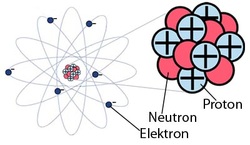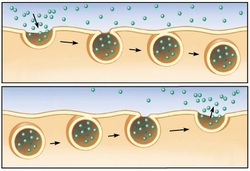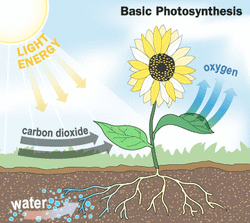Chapter 3
Cell Processes
Chemistry of Life

Courtesy of Our Energy
In this section, I learned about what the everything is made of. I learned about matter, which is anything that has mass and takes up space. I also learned about atoms, which make up matter. All atoms have a nucleus with protons and neutrons in them, with electrons outside the nucleus. Electrons take part in chemical reactions, so they are important in the atom. The electrons have a negative charge, neutrons have no charge, and protons have a positive charge.
Everything in the world is made up of elements. They cannot be broken down into a simpler form by chemical reactions. Each element has a letters that make up a symbol. For example, oxygen is O, hydrogen is H, carbon is C, Sulfur is S, and Potassium is K.
Molecules and compounds are different types of atoms put together. Compounds are made up of two or more elements in exact proportions. Compounds have different properties than the elements they are made of. Some examples of compounds are water and sugar. A molecule is a group of atoms held together by the energy of chemical bonds.
A mixture is a combination of substances in which individual substances retain their own properties. Mixtures can be solids, liquids, gases, or a combination of them. Solutions are a type of mixture where two or more substances are mixed evenly. Suspensions are also types of mixture. A suspension is forms when a liquid or a gas has another substance evenly spread throughout it.
Organic compounds always contain carbon and hydrogen and are usually associated with living things. Inorganic compounds are made from elements other than carbon.
Water is very important for living things. All organisms are made up of more than fifty percent water, and humans are made of sixty to seventy percent. Many animals have blood that mostly consists of water.
Everything in the world is made up of elements. They cannot be broken down into a simpler form by chemical reactions. Each element has a letters that make up a symbol. For example, oxygen is O, hydrogen is H, carbon is C, Sulfur is S, and Potassium is K.
Molecules and compounds are different types of atoms put together. Compounds are made up of two or more elements in exact proportions. Compounds have different properties than the elements they are made of. Some examples of compounds are water and sugar. A molecule is a group of atoms held together by the energy of chemical bonds.
A mixture is a combination of substances in which individual substances retain their own properties. Mixtures can be solids, liquids, gases, or a combination of them. Solutions are a type of mixture where two or more substances are mixed evenly. Suspensions are also types of mixture. A suspension is forms when a liquid or a gas has another substance evenly spread throughout it.
Organic compounds always contain carbon and hydrogen and are usually associated with living things. Inorganic compounds are made from elements other than carbon.
Water is very important for living things. All organisms are made up of more than fifty percent water, and humans are made of sixty to seventy percent. Many animals have blood that mostly consists of water.
Moving Cellular Materials

Courtesy of Running Strong- A Science Library
There are many types of transports in the cell. There is diffusion, osmosis, and facilitated diffusion, which are passive transports. There is also active transport, endocytosis, and exocytosis. Diffusion is the random movement of molecules from an area where there is relatively more of them to an area where there is relatively fewer of them. Molecules of a substance will keep moving from one area to another until the relative number of these molecules is equal in two areas. Equilibrium is reached when the molecules in two areas are relatively equal. When equilibrium is reached, diffusion stops.
Osmosis is the diffusion of water through a cell membrane. Water is needed in cells to carry out life processes, so osmosis is very important. When osmosis occurs, cells become strong and firm. To allow osmosis to happen, cells have to have a slightly permeable membrane, which means that certain things can get in and out, but certain things cannot.
Facilitated diffusion is when glucose molecules need transport proteins to help them enter the cell. Facilitated diffusion is a type of passive transport.
Active transport is when an input of energy is needed to move materials through a cell membrane. Active transports involve transport proteins, just like facilitated diffusion.
Endocytosis is a process used by the cell to take in substances. The cell surrounds the substance with he cell membrane, so that the substance is in the cell. The substance is contained in a vesicle.
Exocytosis is almost the exact opposite of endocytosis. In exocytosis, the cell wants something out of the cell. That substance is surrounded in a vesicle. The cell membrane fuses with that vesicle, and the substance in the vesicle is released outside the cell.
Osmosis is the diffusion of water through a cell membrane. Water is needed in cells to carry out life processes, so osmosis is very important. When osmosis occurs, cells become strong and firm. To allow osmosis to happen, cells have to have a slightly permeable membrane, which means that certain things can get in and out, but certain things cannot.
Facilitated diffusion is when glucose molecules need transport proteins to help them enter the cell. Facilitated diffusion is a type of passive transport.
Active transport is when an input of energy is needed to move materials through a cell membrane. Active transports involve transport proteins, just like facilitated diffusion.
Endocytosis is a process used by the cell to take in substances. The cell surrounds the substance with he cell membrane, so that the substance is in the cell. The substance is contained in a vesicle.
Exocytosis is almost the exact opposite of endocytosis. In exocytosis, the cell wants something out of the cell. That substance is surrounded in a vesicle. The cell membrane fuses with that vesicle, and the substance in the vesicle is released outside the cell.
Energy For Life

Courtesy of The Encyclopedia of Earth
Metabolism is the total of all chemical reactions in an organism. Chemical reactions need enzymes. Enzymes cause changes in molecules. Enzymes can cause molecules to join together, and it can cause them to break apart. Without correct enzymes, chemical reactions in cells could not happen. All chemical reactions in cells require a specific enzyme.
Producers are organisms that can make their own food. Consumers are organisms that cannot make their own food. Organisms that can make their own food do it by a process called photosynthesis. In photosynthesis, producers use light energy from the sun to make sugars that are used as food.
Respiration is when chemical reactions occur that break down food molecules into simpler substances and release their stored energy. In respiration, some of the energy used is turned to thermal energy, which is why when you burn energy, you feel warm or hot.
Fermentation is a process used when cells do not have enough oxygen for respiration. When fermentation happens, some waste products could be lactic acid, alcohol, or carbon dioxide, or CO2, depending on the type of cell. When lactic acid is a waste, it could cause your muscles to feel sore or stiff.
Yeast carries out fermentation when being baked in bread. As the bread bakes, the alcohol is lost and the carbon dioxide is what causes the bread to rise.
Photosynthesis and respiration are almost exact opposites of each other. Photosynthesis uses sunlight energy, CO2(carbon dioxide), and H2O(water) to make sugars and oxygen(O2). Respiration uses sugars, sunlight energy, and O2(water) to make CO2(carbon dioxide) and H2O(water).
Producers are organisms that can make their own food. Consumers are organisms that cannot make their own food. Organisms that can make their own food do it by a process called photosynthesis. In photosynthesis, producers use light energy from the sun to make sugars that are used as food.
Respiration is when chemical reactions occur that break down food molecules into simpler substances and release their stored energy. In respiration, some of the energy used is turned to thermal energy, which is why when you burn energy, you feel warm or hot.
Fermentation is a process used when cells do not have enough oxygen for respiration. When fermentation happens, some waste products could be lactic acid, alcohol, or carbon dioxide, or CO2, depending on the type of cell. When lactic acid is a waste, it could cause your muscles to feel sore or stiff.
Yeast carries out fermentation when being baked in bread. As the bread bakes, the alcohol is lost and the carbon dioxide is what causes the bread to rise.
Photosynthesis and respiration are almost exact opposites of each other. Photosynthesis uses sunlight energy, CO2(carbon dioxide), and H2O(water) to make sugars and oxygen(O2). Respiration uses sugars, sunlight energy, and O2(water) to make CO2(carbon dioxide) and H2O(water).
